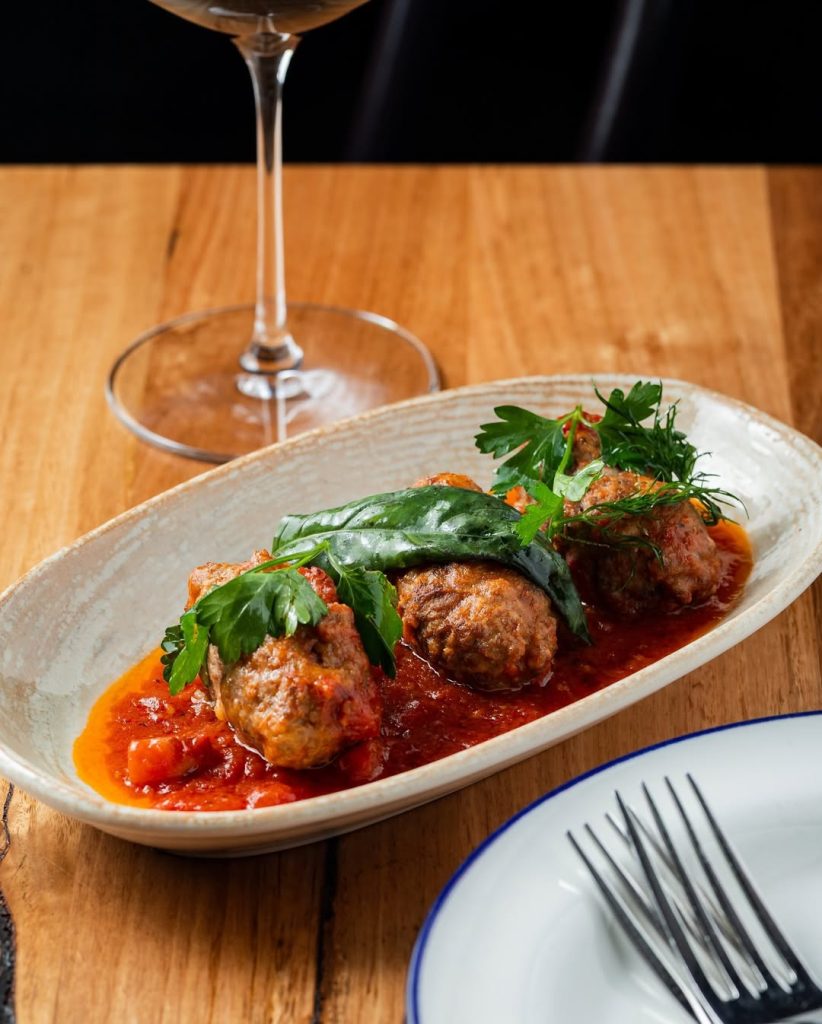
Kitchen Kind #18
Eleftheria 'Thierry' Amanatidis
The author of "Ela na Fáme!"
Eleftheria Amanatidis (Thierry) is the author of "Ela na Fáme!" (“Come and Eat”) and the driving force behind the celebrated Eleni’s Kitchen, Jimmy’s Deli and Cakes by Thierry. Thierry speaks to us about the importance of sharing culture through food, creating bridges between her ancestors and her Melbourne community.

What dish or ingredient speaks of love to you and why?
Something as simple as a mix of salt, pepper, olive oil and oregano. The smell of that, the flavour of that is special – the grandparents used to cook for us, and that’s what you would smell. Being Greek, it’s a bit of a cliche – but you’ve got your drum of olive oil, your Greek-grown oregano. That’s the basis of all our food culture, and those ingredients resonate with me a lot.
Soutzoukakia – meatballs in a tomato-based sauce – is also important to me. It was my grandfather’s signature dish, something he cooked often while we were growing up, and he passed his love for it to us. You can find it all over Greece — it’s not specific to one region — but because it’s such comforting, wholesome food, you often find it in the north, where my family is from. It’s wholesome, warm, soulful food.

When you think of tradition or ritual, what dish or ingredient comes to mind?
In all of our households, whatever the celebration, whether it’s a name day or a birthday or anything, the dish we share is a pite. We are Pontian, which is modern-day Turkey, but it’s ancient. Pontians are known everywhere for our ‘pita – and we make a tiropita, hand-stretched. It’s a side dish or a snack and is featured at every party. At Easter or Christmas, there is never a spread without it. It’s special to me also, because I am the only one in my family who knows how to make it. My Yia Yia is ninety now, and hand-stretching the dough is hard work, rolling it out, buttering it. I learnt it from her, and she learnt that from her grandmother, her elders, and they learnt it from their ancestors. Traditions die out if you don’t keep them alive. Where we come from, pita is what we’re known for.
When our ancestors came here, they carried with them the knowledge and culture they had left. They passed that down to us. When I was young, my sister and I went to the Pontian Association and learnt traditional dance. Places like that are so important — they pass culture down to the next generation. That’s how traditions survive.
When a friend or family member comes over, what is a dish you like to cook for them?
Something my grandmothers used to cook in the oven was Kokkinisto – chunks of meat that are cooked in the oven and finished with macarounia – something similar to spaghetti. We grew up eating Kokkinisto, and now I share it because it’s wholesome food that feels like home to anyone.
You’ll find the recipe in my cookbook, which I wrote while the restaurant was shut. Each dish in the book holds a memory. When you’re young, you think your family will be around forever, but that’s not how life works. People pass, and it’s up to us to keep their stories and culture alive. That’s what food is: it’s memory, history, identity. This book is my way of documenting that, of making sure it’s not lost.
Beef Kokkinisto (beef casserole)
Feeds 6-8
- Olive oil, for cooking
- 1kg beef chuck, cut into 5cm chunks
- 1 brown onion, diced
- 1 clove garlic, finely sliced
- Salt, freshly ground black pepper and Greek oregano, to taste
- 3 dry bay leaves
- 1 cinnamon stick (optional)
- 1 whole clove (optional)
- 1 cup (250ml) tomato passata
- 1/4 cup (60ml) white wine
- 500g spaghetti or kritharaki (risoni), to serve
- 200g good quality Greek feta, sliced, to serve
Heat enough olive oil in a large saucepan, over medium-high heat to cover the base generously. Sear the beef for 8-10 minutes or until well browned. Transfer to a plate with a slotted spoon. Now throw in the onion and garlic and cook for 5 minutes or until softened.
Return the beef to the pan and season with salt, pepper and oregano.
Add bay leaves, cinnamon stick and cloves, if using. Stir well.
Once the beef and vegetables have become one and the flavours have married (after about 5 minutes), add the passata, white wine and enough water to cover the ingredients. Bring to the boil over medium heat, then reduce the heat to low and simmer, uncovered, for 1-1 1/2 hours or until the meat is tender.
Pour into a large, 4-litre capacity, deep baking dish.
Preheat the oven to 200°C (180°C fan-forced).
Meanwhile, boil the pasta according to package directions or until just al dente. Reserve about 1 cup (250ml) of the cooking water and drain the Pasta.
Put the pasta and reserved pasta cooking water into the dish with the meat mixture, give it a good stir and bake for 30 minutes; or until the mixture has thickened, the pasta has absorbed much of the sauce and is slightly crispy on top.
Serve with the sliced feta on top.
Turnip Media recognises the Wurundjeri as traditional owners of the land on which we live and work.
We pay respect to their elders, past, present and emerging.